#Cobra R-spec
Explore tagged Tumblr posts
Text






FPV GT Cobra R-spec, 2008. A special edition of 400 BF Falcon sedans fitted with a 405hp version of Ford's 5.4 litre DOHC Boss 290 V8. The blue on white finish referenced the Falcon XC Cobra Coupé of 1978. Ford Performance Vehicle dealers charged vastly more than the RRP when the cars went on sale, with many buyers also selling the cars at a premium.
#FPV#Ford Performance Vehicles#FPV GT Cobra R-spec#2008#limited edtion#special edition#Cobra R-spec#sports saloon#Falcon GT#Ford Falcon BF#Boss V8#DOHC
164 notes
·
View notes
Text

1969 Ford Mustang Mach 1
World's Only 1969 Ford Mustang Mach 1 390 With a Factory Sunroof Comes out of Hiding
Introduced for the 1969 model year, the Mach 1 was one of no fewer than six performance Mustangs available at the time. Sold alongside the GT, the Boss 429 and 302, and a pair of Shelby models, the Mach 1 became hugely popular. Specifically, Ford sold a whopping 72,458 units, almost a quarter of all Mustang production that year.
What made the Mach 1 such a big hit? Well, for starters, the package included more goodies than the GT. It came with a matte black hood with racing-style pins, a scoop, a unique stripe package, and an upgraded suspension. And unlike the Boss and Shelby models, it wasn't restricted to a specific engine.
Ford offered a more affordable version equipped with the two-barrel 351-cubic-inch (5.8-liter) Windsor V8. Customers who wanted more than 250 horsepower had access to the four-barrel variant, which delivered 290 horses. The options list also included the FE-type 390-cubic-inch (6.4-liter) unit good for 320 horsepower.
But unlike the GT, the Mach 1 was also available with the mighty 428-cubic-inch (7.0-liter) Cobra Jet V8. Offered in both Ram Air and non-Ram setups (Q- or R-code), the Cobra Jet mill generated 335 horsepower. While not quite as potent as the NASCAR-spec V8 in the Boss 429, it was the most potent mill customers had access to in the regular-production 'Stang.
High sales numbers also mean that first-year Mach 1 is quite the common classic nowadays. Sure, the Cobra Jet version is rarer at around 13,000 units, but it's a model you won't have issues finding. And it's not awfully expensive either.
That's not to say that some Mach 1s aren't very rare or unique. But that depends on features and the color combo. Sometimes, it takes a tiny item like air conditioning combined with an unlikely exterior/upholstery color match-up to turn a Mach 1 into a rare gem. This 1969 example in Gulfstream Aqua blue is a tad different because it flexes an option you won't find on any other Mach 1.
You won't notice it at first glance, but look closer, and you'll eventually see that this Mustang rocks a sunroof. Wait, what? A first-generation Mustang with a sunroof? You bet that's a weird feature because Ford did not offer such an option on the Mustang at the time. But a sunroof was available on the Mercury Cougar, and apparently, someone convinced Ford to put it on a Mach 1.
That someone is none other than Carroll Shelby, the man responsible for the cool GT350 and GT500 that turned the first-gen Mustang into a proper muscle car. And the story goes it's one of only two 1969 Mach 1s with a factory sunroof, so it's pretty much a one-of-one if we also factor in the options and the paint.
So what is the story behind this 'Stang? Did Carroll order it for his personal collection? Well, not exactly. Apparently, the car was specified for a doctor who took care of Shelby's mother. He asked if there was anything he could do for him in return, and the doctor requested a Mach 1 with a sunroof. Still working with Ford at the time, Carroll made some calls and turned the doctor's request into reality.
More than 50 years later, this unique Mach 1 is still around. And based on the way it looks, it went through a rotisserie restoration. It's spotless from every angle, and the Gulfstream Aqua color shines better than when this muscle car was new.
The blacked-out hood hides a 390 FE V8, so this Mustang wouldn't normally be as desirable and valuable as a Cobra Jet. However, that factory sunroof gives one-of-one status and puts it into six-figure territory. Hit the play button below to watch it sitting pretty at the MCACN show.
151 notes
·
View notes
Text
Acura Integra A-Spec et la nouvelle Cobra
Le 18 mai 2023
Voici donc le troisième véhicule d’une demi-douzaine qui m’ont été proposés par Honda, la sportive berline Acura Integra mais dans sa finition A-Spec. Pour ceux qui ne suivent le marché automobile que depuis quelques années, sachez que le nom Integra représentait, au départ en 1986, une voiture sportive commercialisée par la division plus luxueuse Acura de Honda. Mais, en 2006, le constructeur japonais décidait de changer ce nom pour celui de ILX avant de changer d’idée en 2021 et de raviver la marque. Toutefois, alors que dans le passé, le nom Integra représentait l’esprit sportif de la marque Acura, cette fois, on dirait qu’il représente plus une version de luxe de la berline Civic (dont elle découle). Ce qui a déçu les amateurs un peu plus âgés d’Integra, c’est qu’il n’y n’ont pas reconnu la très sportive voiture du passé, une situation qui a été corrigée avec l’apparition récente de la version Type R de la même voiture.
Donc, lorsque j’ai pris livraison de l’Integra A-Spec, je m’attendais à un peu de Civic mais beaucoup de luxe du style Acura. J’ai décidé de ne pas me fier à mon essai de la Civic Touring d’il y a deux semaines et de partir avec une toute nouvelle impression. Qui plus est, j’ai aussi voulu inclure une «road trip» à l’agenda. Était-ce une bonne idée?
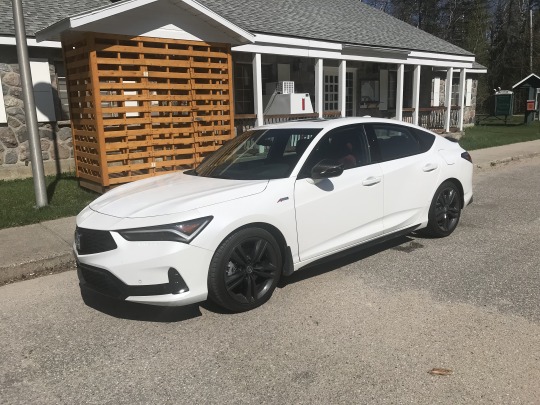
Il n’y a pas à dire, l’Acura Integra est une belle voiture. (Photo Éric Descarries)
Au départ, il est évident que la carrosserie de la nouvelle Integra est plus impressionnante que celle du modèle d’origine. La ligne en est aussi plus luxueuse. Oui, cette Integra semble inviter non pas à la conduite sportive mais plutôt à du «touring» de longue haleine. On aime ou on n’aime pas le design, c’est selon. Moi, j’ai aimé dès le début mais jamais je n’ai pensé comparer la nouvelle Integra avec l’ancienne.
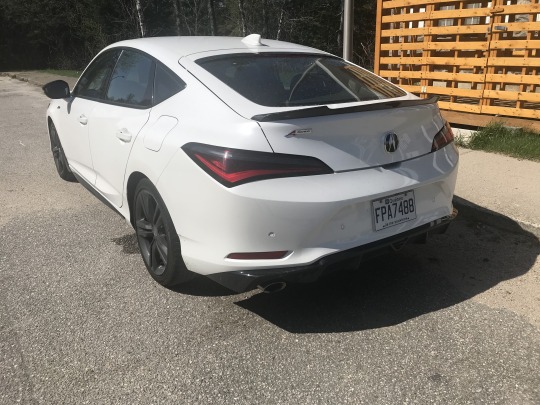
Même de l’arrière, l’Integra se présente avec style. (Photo Éric Descarries)
Sur papier, force nous est d’admettre que l’Integra repose sur une plateforme extrapolée de celle de la Civic. Les deux autos sont aussi plus imposantes, comme je le soulignais pour la Civic il y a deux semaines. Évidemment, la nouvelle Integra n’est disponible qu’en berline à quatre portes (l’originale était, à l’époque, un beau coupé sportif à deux portes). La configuration «automobile» laissant de plus en plus sa place à celle des «camionnettes» et des «VUS», c’est rafraîchissant de voir une nouvelle berline nous apparaître.
L’intérieur de l’Integra
Bien entendu, la première chose que le pilote d’Integra voit en se glissant (parce qu’on ne monte pas à bord d’une Integra, on s’y glisse) derrière le volant de cette Integra, c’est le tableau de bord qui est…identique à celui de la Civic (en fait, presque tous les tableaux de bord des produits Honda que je conduis de ces temps-ci sont presque pareils!). Le bloc d’instrumentation est presque identique, l’écran central est de même dimensions à la même place, la finition de la garniture est très semblable alors que le volant en est pareil avec des fonctions semblables. La console centrale de mon Intégra d’essai était différente de celle de la Civic surtout parce que mon Integra était à boîte manuelle.

Le tableau de bord, aussi pratique soit-il, est aussi pareil à celui de la Honda Civic. (Photo Éric Descarries)
Toutefois, vu que l’Integra représente la marque Acura qui se veut plus luxueuse, sa finition intérieure en est plus poussée. La sellerie de cuir de mon véhicule d’essai était de couleur rouge sur fond noir et son design était de très bon goût. Au départ, on apprécie le bon support latéral des sièges baquets d’avant mais on sent que le coussin du fond n’est pas très épais. Les sièges d’arrière, toutefois, m’ont paru plus de finition plus banale. Tout rouge sans rebord noir, ils sont plats et n’offrent pas de support. Cependant, leurs dossiers sont rabattables pour former un coffre plus grand à plancher plat.
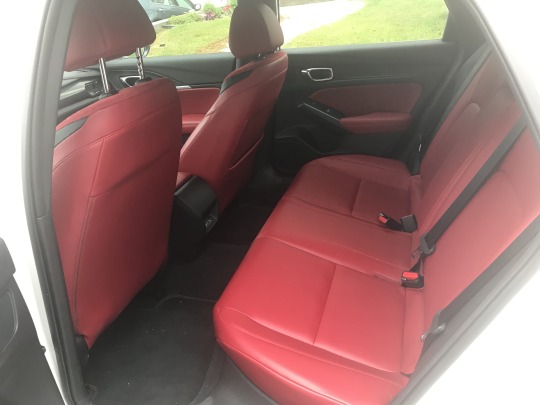
Les places arrière sont moins attirantes à l’œil que celles d’avant. (Photo Éric Descarries)
Même si les dossiers sont relevés, l’utilisateur d’Integra aura droit à un coffre suffisamment vaste pour les bagages de deux voyageurs. La toile cache-bagages sous la lunette arrière aide à cacher les objets de la vue. J’oubliais de vous dire que l’Intégra est une voiture à hayon (hatchback). Toutefois, sa lunette arrière n’aide pas beaucoup à la visibilité à partir du rétroviseur.
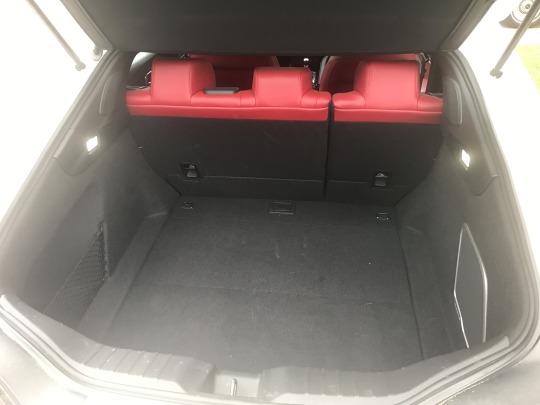
Le coffre, malgré tout, est relativement grand. (Photo Éric Descarries)
Question mécanique, on est bien servi par le moteur à quatre cylindres turbocompressé de 1,5 litre de Honda qui, dans le cas de ma voiture d’essai, était combiné à une boîte de vitesses manuelle à six rapports si facile à manipuler. Ce moteur (qui préfère l’essence Super mais qui performe bien avec la formule régulière) développe 200 chevaux et 192 livres-pied de couple. Ah oui! L’Integra n’est livrable qu’avec la traction avant! Cette auto, je le répète, repose sur une plate-forme identique à celle de la Honda Civic. Et cette plate-forme ne date que de 2022! Par contre, les ingénieurs de Honda s’empresseront de vous dire que les réglages du moteur, de la boîte de vitesses (l’automatique CVT, bien entendu) et de la suspension électronique ont été revus pour l’Integra. En passant, cette suspension peut être modifiée par le conducteur pour être Confortable, Régulière ou Sportive. On note une certaine différence entre les trois réglages mais elle n’est pas dramatique…sur une belle route. Ces mêmes ingénieurs seront aussi pressés de vous dire que la structure de l’Integra est plus rigide que celle de la Civic (pour la conduite sportive, je suppose…). Les pneus équipant la voire d’essai étaient des Continental Conti Pro Contact 235/40-R18 avec de gros renforts extérieurs aux flancs pour protéger les jantes.

Ma voiture d’essai était mue par le quatre cylindres turbocompressé de 1,5 litre de Honda. (Photo Éric descarries)
Sur la route
Donc, je me suis dit que, vu qu’il s’agit d’une luxueuse voiture de tourisme, elle serait le sujet idéal pour un «road trip» chez mon fils en Abitibi. Ai-je bien fait? Continuez de lire…
Évidemment, en conduite urbaine, l’auto est amusante à piloter. Sa suspension, même en mode Confort, est bien adaptée à la conduite un peu plus sportive. Grâce aux pneus de performance Continental, on peut se permettre quelques petits «exploits» sur une route sinueuse. La direction est égale à celle de la plupart des Honda, un peu légère mais très précise. Le freinage est relativement puissant mais il ne faut pas en exagérer. Question performance, l’Integra A-Spec est capable d’accélérations sous les huit secondes pour atteindre le cap des 100 km/h. Et même avec quatre personnes à son bord, cette Acura permet des reprises rassurantes! En ce qui me concerne, j’ai aimé l’affichage de la vitesse par réflexion dans le pare-brise. Dans bien des cas, la limite de vitesse y est aussi affichée. Toutefois, j’aurais bien voulu qu’un indicateur au tableau de bord me dise en quel rapport l’auto est (rappelez-vous, c’est une boîte manuelle). Je dis cela parce que le petit moteur aime tourner à haut régime (quelque 3000 tr/mn à 120 km/h) mais, parfois, c’est trompeur. Question visibilité, la vue arrière n’est pas toujours facile vu l’inclinaison de la lunette.
Ayant bien ajusté le mode de suspension en Confort, j’ai donc pris la route pour La Corne (petit village entre Val d’Or et Amos où se trouve cette fameuse mine de lithium tant célébrée par les «spécialistes» de voitures électriques.
Parti de Laval, j’ai pris la 19-335 pour rejoindre la 640 puis l’autoroute des Laurentides, la 15 qui rejoint la 117 après Sainte-Agathe. Et c’est là que j’ai eu une grande surprise. Le son des pneus était presque aussi évident dans l’habitacle que dans la Civic. J’aurais cru qu’en faisant de l’Integra une voiture presque luxueuse, Honda aurait ajouté plus d’isolant au niveau des passages de roues! Mais ça ne semble pas être le cas. Quand j’ai mentionné ce problème avec la Civic, les «observateurs» et «experts» à qui j’en avais parlé ont été vite à me dire que c’était la faute des pneus Goodyear Eagle «américains» (vous savez, ce US bashing qu’ils adorent!). J’ai hâte de leur dire que j’ai vécu une situation semblable avec l’Integra et ses pneus Continental…allemands! Évidemment, ce son diffère selon le revêtement du pavé (et pour cela, celui de l’autoroute des Laurentides est assez rugueux!). Mais disons que lorsque je voulais parler à ma compagne, il fallait que l’on baisse la radio (avec son excellent son ELS Studio que je n’ai pu apprécier à sa juste valeur). En passant, il n’y avait pas de système de navigation à bord de l’auto. Vive les téléphones intelligents.
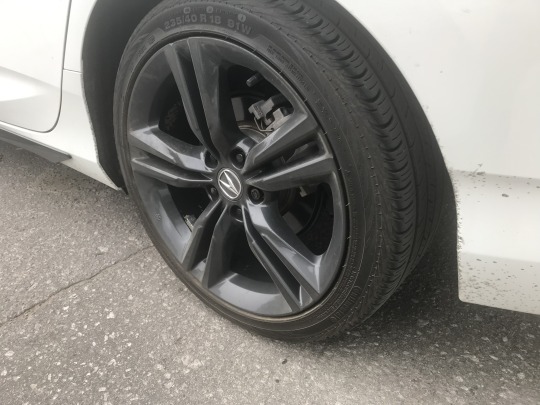
Les pneus Continental aident au comportement routier de l’integra mais ils pourraient être vulnérables aux nids-de-poule de la 117! (Photo Éric Descarries)
La conduite de l’auto fut facile durant les six heures de voyage à l’aller et aux autres six heures de retour. Cependant, les sièges qui semblaient si invitants au départ se sont avérés plutôt durs au fur et à mesure que je conduisais. J’avais prévu le coup car depuis quelques années, je me suis habitué au confort des coussins supplémentaires (20$ chez Canadian Tire) pour les longues randonnées. Par contre, ma femme qui ne se plaint jamais de la dureté des sièges n’en pouvaient plus au bout de quelques heures!
Mais, si je semble être devenu in «Honda basher» (on m’a déjà accusé d’être une «Toyota basher» dans le passé), sachez que j’ai bien aimé l’Integra A-Spec. C’est une auto rapide, agile et agréable à conduire…sauf pour de longues périodes surtout sur des routes au revêtement endommagé!
En ce qui a trait à la consommation, j’ai obtenu une moyenne de 6,63 l./100 km ce qui est louable (alors que l’ordinateur de bord indiquait 6,9). Le prix de base d’une Acura Integra régulière est de 36 725 $ mais dans le cas de mon modèle d’essai A-Spec, il serait plutôt de 44 925 $.
Je termine donc cet essai routier en spécifiant que j’ai bien aimé conduire cette auto qui est pimpante, rapide et très à l’aise sur des routes sinueuses. Les seuls reproches que j’ai à lui faire, ce sont au niveau de la pénétration du son des pneus dans l’habitacle et le confort déficient des sièges qui ne se dévoile qu’après une longue conduite. Peut-être me direz-vous que cette auto est plutôt destiné à de jeunes conducteurs qui sont plus tolérants de tels «défauts» mais, moi, j’aime parcourir de longs trajets en «road trip». Et à ce niveau, l’Integra A-Spec ne se qualifie pas. Pour le reste, c’est une bagnole «le fun»!
La 15-117? À réparer…et ça presse!
Conduire sur la 117 commence à devenir une aventure dangereuse. Elle débute comme l’Autoroute 15 des Laurentides et son revêtement est tellement rugueux que dans des voitures comme l’Integra A-Spec, le son des pneus sur le pavé transmis dans l’habitacle est si élevé qu’il devient difficile de se parler. Et, près de Saint-Jérôme et à la branche menant vers Saint-Sauveur, les ornières sont si profondes qu’il serait possible de perdre le contrôle de l’auto.
Plus loin, non seulement ces ornières reviennent avec une vengeance mais aussi, les nids-de-poule se multiplient (l’asphalte posée sur le fond de béton n’y tient pas!). Heureusement, je n’ai pas coupé de pneus à taille basse en passant dans de tels trous mais il est difficile de tous les éviter…ce qui devient une aventure à raconter (et je ne mentionne pas ici ma rencontre avec un orignal sur le bord de la route…je ne l’ai pas photographiée, ce que j’aurais dû faire). Disons qu’il vaudrait mieux avoir une camionnette avec des pneus de grande taille pour voyager sur la 117 vers Val d’Or!
Mon rêve…revisité!
Ceux qui me connaissent savent que j’ai toujours rêvé de posséder une Cobra et ce, depuis mon adolescence. Ce rêve s’est réalisé il y a presque quinze ans lorsque j’ai réussi à me procurer une de ces populaires répliques, la mienne ayant été construite par (depuis ce temps) mon grand ami Michel Pigeon.
Mais voilà que le constructeur original des carrosseries de Shelby Cobra, AC Cars d’Angleterre, a décidé de commencer la production d’une nouvelle Cobra, celle-ci sous le nom d’AC Cobra GT Roadster. Partant avec un nouveau châssis en partie en aluminium, AC Cars nous présente un roadster en fibre de carbone (l’originale avait une carrosserie en aluminium) affichant des lignes nous rappelant la Cobra originale telle que créée par le légendaire Carroll Shelby (le dessin original nous provenait d’un légendaire designer, John Tojeiro qui avait été inspiré des barquettes (roadsters) Ferrari du début des années cinquante). . Toutefois, la nouvelle Cobra GT est plus longue et plus large que l’originale alors qu’elle pèse environ 1000 livres de plus que le modèle de 1962.
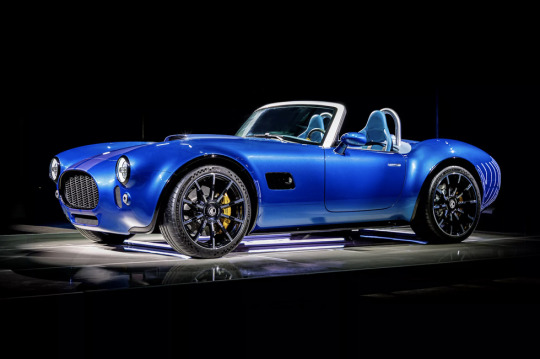
La nouvelle AC Cobra GT Roadster telle que proposée par AC Cars. (Photo AC Cars)
Vous vous demandez quelle sorte de moteur sera offert avec la Cobra GT Roadster? AC Cars a annoncé que son nouveau roadster sera livrable avec un Ford V8 Coyote de 5,0 litres atmosphérique de 454 chevaux ou une version suralimentée par compresseur mécanique du même moteur à 654 chevaux. Toujours une voiture à propulsion, l’acheteur aura le choix entre une boîte mécanique à six vitesses ou une automatique à dix rapports! La Cobra GT avec le moteur suralimenté devrait être capable d’atteindre le cap des 96 km/h (60 m/h) en quelque 3,4 secondes (dire que la version de 1962 avec le «small block» de 260 pouces cubes (4,2 litres) le faisait en 4,2 secondes!).
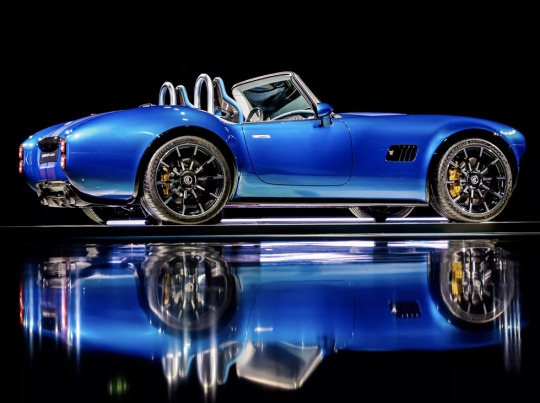
La «nouvelle» Cobra vue d’un autre angle. (Photo AC Cars)
AC Cars ne prévoit en construire que 250 unités (la production des Cobra originales 260-289-427 de 1962 à 1966 n’aura été que de 996 unités) alors que le prix n’en a pas encore dévoilé. On ne sait même pas si certaines de ces autos atteindront l’Amérique du Nord. Mais lorsque le prototype fut dévoilé il y a quelques mois, il était question de plus de 350 000 $! Je crois que je vais garder la mienne!
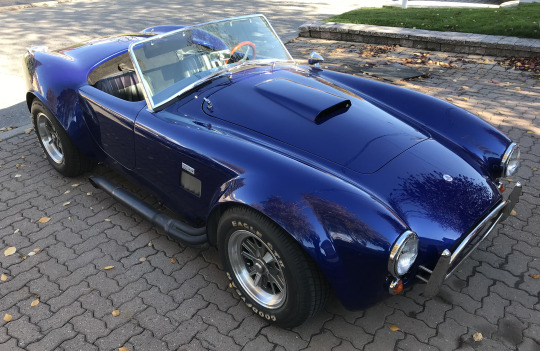
J’aime mieux ma Cobra! (Photo Éric Descarries)
0 notes
Text
Frosty The ST180
I have owned the car since March 2017 and already have a pretty list of modifications on the car. A lot of these modifications were done in the wrong order by yours truly, but being young, dumb and naive I didn't know any better! My goal with this car is to make it into something truly unique, to create something which I can enjoy track days in but also drive daily, keeping it as reliable, safe and clean as possible.
Because I've done so many modifications to the car, I thought it would be best to compile a list for you, because who doesn't love a cheeky list? I will go over my current modifications and Future Modifications!
Current Modifications (21.01.2018):
Engine and Bay: PERON "Stage 3" V1 Map 270 BHP @ 1.6 BAR - £300 PRO Primary Intake Hose (Black) - £70 FORGE Crossover Pipe (Wrapped In Gold Heat Tape) - £140 Velossatech Big Mouth - £100 Funk Motorsport Cone Filter - £25& Airtec Maf Housing - £80 Airtec Turbo Elbow (Wrapped In Gold Heat Tape) - £100& Airtec Torque Mount (Purple Insert) - £70 Laird Performance "Outlaw" Stage 2 Intercooler - £260 GFB DV+ - £104 Cobra 3" Decat Downpipe - £200 Custom Powerflow Exhaust 2.5" Resonated + Muffler - £350 AET Turbos V1 Hybrid Turbo - £550 Mountune Dual Mass Clutch and Flywheel - £650 Boost Gauge Adapter - £30 Symposer Delete - £9.99 Total: - £3038
Handling: Rota Attack 15" ET18 - £400 Yokohama Parada Spec 2 (Came with wheels, awful!) 15MM Hubcentric Wheel Spacers - £142 Driftworks Steel Wheel Nuts (Neochrome) - £25 H&R 35mm Lowering Springs - £150 Project Mu Rear Pads - £25 EBC Yellowstuff Front Pads - £90 HEL Braided Brake Lines All Around (Transparent) - £80 ATE 200 Fluid Total: - £912
Exterior: OEM Grille with lower recess delete (Will come in handy for oil cooler) Custom Frosty Fez Spoiler Profiles Powdercoated Gloss Black - £250 Backyard Civics Wing Blade W/ GT Endplates - £150 Wiper Delete DIY Gloss Black Rear Honeycomb Maxton Design Rear Diffuser - £90 Wide Arch Kit By Airtec - £395 Total: - £885
Interior: CAE Ultra Shifter - £1068 Rear Seat Delete - Free First Aid Kit - Free Bride Replica Carbon Kevlar Buckets - £350 Genuine Blue Sparco Harnesses (Came With Old Bucket Seats) Airtec Half Cage (Powdercoated in RAL5012 Blue) - £595 DC 3D Designs Vent Pod DC 3D Designs Handbrake Hole Filler Turbosmart Vent Pod Boost Gauge - £35 Total: - £2048
Total In Mods So Far: - £6883 (Give or Take)
Future Modifcations in the pipeline (12.01.2018):
Engine and Bay: Airtec Oil Catch Can - £180 APS Oil Cooler - £78 MOCAL Oil Cooler Fitting Kit - £98 Turbo Cooler - ? Quaife LSD - £812
Total: - £1168
Handling Powerflex Rear Spring Isolators - £55 Powerflex LH + RH Engine and Gearbox Mounts - £25 and £36 Bilstein B14 - £780 Summit Top Strut Brace - £170 Brake Cooling Ducts - ? Total: - £1066
Exterior: Total: - £0
Interior: False Floor Carpetting - £20 Momo Short Hub - £77 Kode Steering Wheel (Leather W/ White Stitch) - £59 Lightweight Door Cards (Trackcardoorcards) - £185 Total: - £341
Future Modifications Total Price: - £2575
DIY SERVICE SCHEDULE:
During my Ownership of this vehicle I would like to keep things as reliable and as healthy as possible. In order to do this I will follow a very strict personal maintenance schedule. The schedule reads:
Oil Change Oil and Filter change to be completed every 4000 miles to keep turbo and engine in good health. Ford Formula F 5W-30 will be used upon every oil change as well as genuine oil filter and replacement sump plug.
Gearbox Oil Gearbox oil will be changed every 10,000 Miles OR every 2 track days, Oil used will be Royal Purple 75W-90 for it's protective properties.
Spark Plugs Spark Plugs will be changed every 15,000 Miles, Spark plugs used will be NGK 96588 LTR6DI-8 Laser Iridium Plugs gapped to 0.6mm
Brake Fluid Brake Fluid will be changed every 10,000 Miles OR every track day, Brake Fluid used will be ATE200 OR Motul RBF600 depending on urgency.
Coolant Topped up when necessary, Flushed every 30,000 Miles (Last Flushed @ 22,000)
Fuel Tappet Fuel Tappet is to be changed every 20,000 Miles to ensure fuel pressure is well maintained
Pollen Filter Pollen Filter will be changed every 10,000 Miles OR ONCE A Year to preserve the cleanliness of the interior (I'm a clean freak!)
Tyre Pressures To be checked ONCE A WEEK
CAE Shifter Adjustments to be checked ONCE A Month OR Every 1000 Miles. If necessary make adjustments using LOCTITE in relevant areas.
Wheel Nuts and Spacers Wheel nuts and spacers to be checked ONCE A Month to ensure they are torqued correctly.
Hinges Hinges to be greased ONCE every 20,000 Miles or ONCE every 2 years.
So For now that is everything! A lot planned and A LOT of money needing to be earned. I hope you guys enjoyed this relatively brief but descriptive thread on my car and I look forward to doing lots of work in the future. This could take years to complete but I'm determined as this is what I thrive off!
Lewis
1 note
·
View note
Photo

【KYOSHO MINI CAR & BOOK SERIES】各2,750円(税込) 以前よりお客様から強いご要望をいただいていました人気のKYOSHO「ミニカー&ブック シリーズ」、下記アイテムを若干数ご用意しました。 まだ入手されていない方、また新たにご興味を持たれた実車ファンの皆様、精巧に造り込まれたミニチュアカーを眺めながらその車の歴史に触れてみては如何でしょう。 K07009YK:No.7 THE CIRCUIT WOLF Yatabe RS K07114WK:No.8 SUBARU Sambar(White) K07002BLK:No.9 Shelby Cobra 427 S/C K07067TP:No.11 NISSAN TRACK EDITION ENGINEERED BY NISMO T-SPEC K07067TJ:No.11 NISSAN GT-R PREMIUM EDITION T-SPEC 皆様のご来店を心よりお待ちしています。
0 notes
Text
The List.. give or take a few
1955 Mercedes-Benz 300 SL Gullwing
1958 Chevrolet Impala Sport Coupe
1961 Chevrolet Impala SS 409 (x2)
1961 Ferrari 250 GT California Spyder SWB
1962 Ferrari 250 GTO
1963 Corvette Stingray Split Window Coupe
1966-67 AC Shelby Cobra 427
1969 Volvo P1800S
1970 Nissan Fairlady Z 432 (PS30)
1970 Maserati Ghibli SS
1970-72 Nissan Skyline KPGC-10 GT-R
1971 Lamborghini Miura P400SV
1971 AMG 300 SEL 6.8
1972 Oldsmobile 442 Cuttlass
1978 Chevrolet Caprice/Impala Landau Aero Coupe (SS)
1981 Porsche 935
1983-89 BMW E24 M635CSi
1987 Buick Regal GNX
1987-88 Porsche 930 Carrera Turbo 3.3L Euro Spec & Auto Garage TBK Body
1988 Mazda FC RX-7 S5 Turbo II Anniversary Edition
1988 Mercedes-Benz 300CE 6.0 AMG
1988-93 Lamborghini LM002
1989 Ferrari F40 Competizione
1989 BMW M3
1991 GMC SYCLONE
1993 Bugatti EB110 GT
1992-94 BMW E31 Alpina B12 5.7
1996 Chevrolet Impala SS
1997 Toyota Camry V6 (Pre-facelift) TRD Edition
1997 Acura NSX Type S (Honda NSX-S JDM)
1998 Lamborghini Diablo (SV or VTTT)
1998 Subaru Impreza 22B STI (GC8E)
2001 Ferrari 550 Maranello
2001-03 BMW E39 M5
2002 Mazda FD RX7 S8 Spirit-R Type-A
2005 Mercedes-Benz E55 AMG
2006 Ferrari 575 GTZ
2006-08 Audi RS4 B7 Avant
2007 Chevrolet Trailblazer SS
2007 Subaru Forester STI
2008 Mercedes-Benz CLK63 AMG Black Series
2010 BMW E60 M5
2012 Chrysler 300C “Modified Hellcat”
2016-17 McLaren P1 LM
2016-18 Rolls-Royce Wraith Black Badge
2018 Porsche 911 Turbo S Exclusive Series
2018 Alfa Romeo Giulia Quadrifoglio
2018 Jaguar XJR575 LWB Sentinel
Knight XV
Batmobile Tumbler
2017 Triumph Daytona 675R
#The List#car collection#ForeignCrates&HeavyChevys#FCHC#porsche#chevrolet#honda#ferrari#lamborghini#mazda#jaguar#alfa romeo#rolls royce#maclaren#alpina#bmw#amg#mercedes-benz#subaru#audi#volvo#nissan#gtr#toyota
2 notes
·
View notes
Text




FPV Super Pursuit Cobra Ute, 2008. In addition to the 400 Cobra R-Spec saloons Ford Performance Vehicles also produced 100 utes (pick-ups) the wore neither GT nor R-Spec badges though the had the same 405hp Boss V8 as the saloon.
#FPV#Ford Performance Vehicles#FPV Super Pursuit Cobra Ute#Ford Falcon Ute#pick-up#2008#limited edition#special edition#Boss V8#Ford Australia#Australian market
192 notes
·
View notes
Photo

RECENTLY LISTED WITH BUYERS WORLD FOR SALE IS THIS AWESOME AND BUILT UP HARLEY THAT'S GOT A BUNCH OF AD ON'S AND IS READY FOR A NEW OWNER CALL NOW!!!
I bought this bike to ride semi-professionally on closed courses. Upgrades include, Ohlins Suspension F&R, Adaptive Headlight with matching passing lights, Turn signal mirrors, Avon Cobras F&R, Vance&Hines pipes, Full HD extended warranty. $45000.00 invested will sell for $30000.00 obo. Only 891kms Since spring of 2020
FOR MORE INFORMATION PHOTO SPECS ETC...CALL
913 647 9576
0 notes
Text
Bush Craft Style 2020 Summer Collection VOL 1
みなさん、こんにちは。

本日は、久しぶりに イタリアンレストラン BAMBINO さんへ行ってきました。

BAMBINO オーナーの帆足氏は、
ビンテージバイクのコレクションが素敵な趣味人。

さり気なくDUCATIが置かれていました。

BAMBINO

落ち着いた店内には風が渡っていました。

パスタランチは1,000円。
ボロネーゼ、絶品です。

今日のパスタランチのセットはプリンとコーヒー。
ごちそうさまでした。(^^)

2018年に取材されました北海道新聞の記事。

今回はブッシュクラフトをテーマに、ウエアを中心にご紹介しましょう。

MILLICAN SMITH THE ROLL PACK 25L MOSS Color ¥27,500
生地素材のBionic Canvas Outer Fabric は、
リサイクルポリエステルを57%と
強度を持たせたハイテナシティ ポリエステル5%を配合した芯材に
コットン38%を巻きつけ、
さらにパラフィンワックス・コーティングを施しています。
ライナー生地はリサイクルポリエステル100%使用。
サスティナビリティなバックパックです。

ウエストベルトを取り外してみました。
バックルはアルミ製で、生涯使い続けられる堅牢性。

サイドジッパーでアクセスできるPCホルスター。

フロントポケット内には様々な小物を収納できるポケット。

ギアループが内蔵。

ギアループは使いたい時に引き出します。

ピッケルを装着してみました。

バックパックのトップにレザーでほきょうされた頑丈なハンドル。

ロールトップはウエアを巻き込んでパッキングできます。

ロールトップにマットを装着してみました。

NEMO SWITCHBACK
Material : ポリエチレン / クローズドセルフォーム
Weight : 415g
Size : 183 x 51 x 2,3 cm
収納サイズ : 13 x 14 x 51 cm
R値 : 2,0
Color : Boreal
Price : ¥7,150

ヘキサゴナル(六角形)シェイプをベースとした独自のデザイン。

硬さの異なる2層のフォーム素材を組み合わせることで
同カテゴリーの一般的なパッドよりも
はるかに快適な寝心地を提供しながらもコンパクトに収納できます。

裏面には熱を反射するサーマルフィルムを装備、
高さのある独自のフォーム形状により
同カテゴリーの一般的なパッドよりも20%も圧縮されない
(空気を溜め込むことができる)スペースを確保し、
より暖かく就寝することができます。

6角形のパターンをクモの巣状に連結することで全体の剛性を高めています。

SWITCHBACK Boreal カラーの在庫は9点。
オレンジカラーは目にしますが、オリーブのレアなカラーがあります。

ブッシュクラフトは森の中にある素材を利用して野営する遊び。
庭師や鳶職のように、装備をベルトに装着します。

頑丈なベルトに水筒と大型ポーチを装着しています。
現地では、シースナイフやファーストエイドポーチなども装着します。

ベルト、水筒、ボトルホルダー、ダンプポーチ。

HELIKON-TEX COBRA TACTICAL BELT ¥8,580
Color : Olive Green
M Size : 110cm
ベルト幅 : 45mm

Austri Alpin のCOBRAクイックリリースバックルを採用。
7075アルミニウム合金と真鍮、ステンレススチールで構成された
腐蝕と摩擦に強い耐久性のあるバックルで、
簡単な操作で素早い脱着が可能です。

ポーランド製。

J-TECH MAGAZINE RECOVERY POUCH
Material : 1000D Nylon
Color : Olive Green
Size : 29 x 25 cm
Price : ¥4,180
ダンプポーチ、ダンプマグポーチ、マガジンリカバリーポーチ
などの名称で呼ばれる、ギア類を放り込んでおける大型ポーチ。
開口部はドローコードで収束できます。

US HAYES TOOLING & PLASTIC INC
Collapsible 1QT Canteen Soft Type
Material : 本体/エチレン酢酸ビニル樹脂、キャップ/ポリエチレン
Volume : 1GT(1クォート)946ml
*湯は注がないでください。
Price : ¥1,430
柔らかいソフトタイプの水筒。
使用後は潰して収納しておけるので邪魔にならず、
水を飲んだ分だけ絞って蓋をすれば、
音を立てることを少なくすることができ、静粛性にも優れます。

身体に沿う湾曲形。

MIL-SPEC MONKEY / TAILOR COLLABORATION BOTTLE CORSET
Color : Coyote
Price : ¥5,720
2本のMALICEクリップでMOLLEウェビングやベルトに装着できる
ボトルホルスターです。

米国タクティカルテイラーとミルスペックモンキーのコラボレーション。
ボトムのベルクロと側面のバンジーコードにより、
ナルゲン広口ボトルやキャンティーンボトルに対応。

ボトルが飛び出さないようにバンジーコードで固定できます。

MECHANIX WEAR THE ORIGINAL GLOVE
Color : Coyote
Price : ¥4,400
メカニックスウェアのスタンダードモデル。
素肌の様なフィット感・使いやすさ・保護力に優れ、
INDY・NASCARのメカニックから
サンディーメカニック達まで幅広く愛用されています。
手のひらはしなやかで、耐久性にすぐれた合成皮革を採用し、
シームレス(縫い目無)にすることにより操作性を失いません。

トップ部分には伸縮性高いの2ウェイストレッチスパンデックス素材を使用。
個々の手にしっかりフィットします。
超薄型TPR(サーマル・プラスチック・ラバー)のプルタブにベルクロを採用。

摩耗しやすい部分は補強されています。
指先は、i phone のスクリーンタッチパネルの操作ができます。
洗濯が出来るので常にフレッシュな使用感を持続出来ます。
丁寧に手洗いを繰り返すことで、
自分の手に馴���んだ自分だけのオリジナルのグローブとなり、
かけがえのないパートナーとしてご愛用頂けます。
ブッシュクラフトは森の中でナイフやナタなどを使って
作業をおこないますので、ストレスの無い操作性と
手を護ることが大事なんです。

BATES RAID MID
Color : Olive Brown
Size : US 8EW ( 27cm ) , US 9EW ( 28cm )
Price : ¥17,380
撥水に優れた本革とナイロン素材をアッパーに使用した
タクティカル仕様のアッパーの堅牢性。
8mmのヒールドロップ(ソールの踵とつま先との高低差)の
防滑性に優れたラバーアウトソール。
軽量でありながら、成型TPU部材のヒールカップにより安定性があり、
森の中で存分に活動できます。

Bush Craft Style 2020 Summer Collection VOL 2に続きます。
続編では、今回、このブログにご紹介するにあたりまして、
店頭販売にて、クリアランス価格のお買い得な商品をご用意しました。
リアルツリーカモのハットと、アームカバー気になるでしょ♪
0 notes
Photo


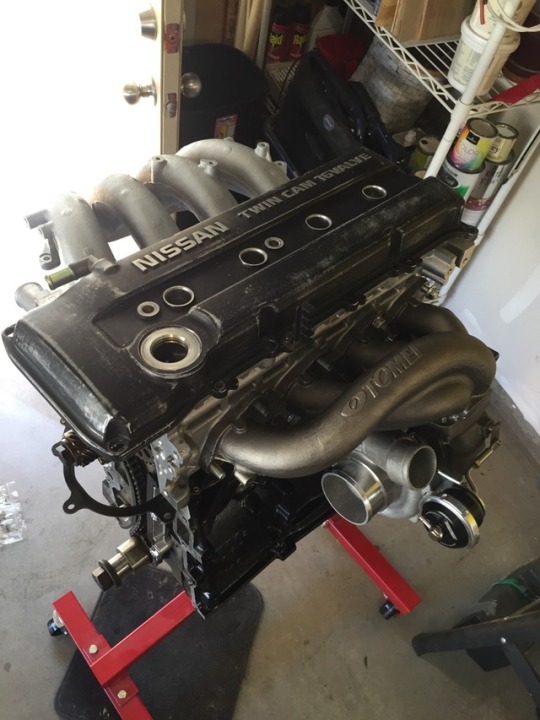

@nick-goldstar
Nick RIDE ✔️ 97’ Nissan 240sx se Suspension: Stance coilovers 14k(swift)/10k springs Pbm era 1 front knuckles Front: Steering rack moved 20mm forward 30mm extended lca Voodoo 13 front tension rods Stealth custom fab front power brace Z32 steel calipers 30mm Moog outer tie rods and maxima inners Rear: SPL toe arms Megan tension and camber arms Welded diff Pmu drift spec brake pads Modded subframe Engine: Ka24det 9.0:1 cp Pistons Manley h-beam rods Full arp studs Light port and gasket match Excessive crank scraper/windage tray Tomei manifold Tomei cams Crower dual valve springs Supertech valves Garrett gt2860rs Turbo smart wastegate actuator Ported wastegate exhaust housing HKS electronic boost controller Pbm cobra r down pipe Jwt ecu 550cc injectors Drivetrain: Spec stage 3 clutch Welded diff Brakes: z32 front Exterior: Vertex ridge front and rear bumpers Origin side skirts Masa hood Ryo tail lights Ganador mirrors Vertex headlights Advan model 5 18x9 +10 Work cr Kiwami 18x9.5 +15 Weds Cerberus 1’s 18x10 +? Interior Key!s steering wheel Tomei shift knob Bride Zeta ii Bride Brix Bride seat rails Dmax floor mats Rear mount battery
69 notes
·
View notes
Photo

Great spec on this one! - • Peron Stage 3 Map (no decel) • AET Motorsports VT330R Turbo w/ Print out • 3” Cobra Sport Decat • Milltek Race System (non-res) w/ Polished Tips • ITG intake & crossover pipe • ProAlloy Stage 3 Intercooler • H&R 35mm Lowering Springs • *Freshly Powdercoated* Fifteen52 Turbomacs 17” • Maxton Front Splitter • Wing Risers • Candy Red Dice Dust Caps • Few other little touches Full spec and images live tomorrow on our website and on Instagram. ______________________________________________ Tags: #fiestast3 #fiestast #stfiesta #aetmotorsport #vodoo #vodoopower #peron #fifteen52 #fordperformance #fordsforlife #fordsofinstagram #fordmania #caroftheday #RSDirect http://ift.tt/2B1qKbw
1 note
·
View note
Text
Mustang Cobra 2000

2000

Test driving 2000 cobra r mustang 5 4 dohc v8 six speed

Svt cobra cars mustang cobra 2000 ford mustang 2004 ford mustang

The ford mustang cobra r is one mean future classic

Motorweek retro review 2000 ford mustang cobra r

Ford svt cobra r 2000 forza motorsport wiki fandom powered by

Ford mustang svt cobra r 2000 pictures information specs

2000 ford mustang svt cobra r t205 kissimmee 2017

200…
View On WordPress
0 notes
Text
Mixing brands of tires via /r/cars
Mixing brands of tires
Hello!
I have an ’86 Jaguar XJS (super low miles) that I have spared no expense getting everything up to spec both cosmetically and mechanically. At this point it is probably better built then when it left the factory – that is saying much I suppose.
When I received the car it hadn’t been driven in a number of years and so one smart thing to do was change the tires. It had Cooper Cobra Radial G/T’s and so I replaced all four with the same tire.
One complaint is that the back end just goes all over the place when making a turn from a dead stop with even moderate throttle (and this isn’t a 0-60 car). I’m 100% sure the setup is solid as every bushing, shock, radius arm, cage, etc. has either been thoroughly inspected or replaced.
So I need some stickier tires. I have already pumped way too much money getting this car to A+ spec and I don’t want to replace all four tires especially since the current tires have less than 200 miles on them. The other issue is the Cobra’s retail for ~$100 and the next step up goes into ~$400+.
Is it a bad idea changing out the rear tires only to help with that back end grip?
On another note – does anyone have an opinion of M&H street tires?
Thank you!
1 note
·
View note
Photo

New Post has been published on http://fastmusclecar.com/best-muscle-cars/muscle-car-prices-2019/
Muscle Car Prices 2019
By Dave Ashton
Muscle cars, like any popular vehicle that has been around for a good few decades, have their up-and-down times with prices. The original muscle cars of the late 1960s and early 70’s are now in some cases moving from the classic to the antique car category. Those vehicles that are over 45 years old and still command a tidy sum. These can also be classed as post-war era vehicles (1948–1972)
In this regard, we thought it would be a good idea to put together a basic overview of the most popular muscle cars and general values. This will include both old and new muscle cars, but don’t take it as a be all and end all list. More to give a general guideline, so you know either how much your current classic is worth or is it worth buying into a certain vehicle.
General information Buying into a classic muscle car can be done for a variety of reasons. The car you always longed for, an investment piece….many reasons. For any vehicle, there is a tick list of criteria which goes towards its ultimate value. Condition and originality – the more original the parts, the better. From seating to engine elements, the more original, the higher the value. Mileage – the lower, the better. Age – not always a factor, but usually the older the better. Rare options – base model cars fetch the least amount, while limited run vehicles with rare options fetch the most. Generally, it’s the popular makes and models, with a bunch of rarely chosen options that fetch the most money.
Modern Muscle When it comes to modern muscle cars, we’re usually talking in the last 15 years or so. The four big contenders are the Chevrolet Camaro, Dodge Challenger, Dodge Charger and Ford Mustang. The Camaro has been in production since 1967, with only a break between 2002-2010. There have been limited edition Camaros over modern years, such as the Z/28.
The Dodge Challenger, which is probably the nearest tip to a classic muscle car, came back in 2008, with some collectors models along the way, such as anniversary editions. But, its the Dodge Challenger Demon with 808HP and only 3,300 units produced which is a current favorite. The Dodge Charger also came back in 2006, with a few limited edition models along the way.
The Ford Mustang has been the longest running pony/muscle car, with loads of options to choose from. Standout models include the GT350 and GT500.
As a brief overview, here are some examples to whet your appetite. Chevrolet 2015 Chevrolet Camaro ZL1: Concours = $50,000, Fair = $25,000 2012 Chevrolet Camaro 45th Anniversary: Concours = $35,200, Fair = $12,100
Dodge 2011 Dodge Challenger SRT8 392 Inaugural Edition: Concours = $44,000, Fair = $17,600 2018 Dodge Challenger SRT Demon: Concours = $165,000, Fair = $100,000
2009 Dodge Charger Daytona R/T: Concours = $26,300, Fair = $10,700 2009 Dodge Charger SRT-8 Super Bee: Concours = $38,000, Fair = $14,200
Ford 2013 Ford Mustang Boss 302 Laguna Seca: Concours = $50,000, Fair = $29,900 2014 Ford Mustang Cobra Jet: Concours = $100,000, Fair = $45,000 2014 Ford Mustang Shelby GT500 Super Snake: Concours = $90,000, Fair = $50,000
Pricing guides The links below should provide you with good variety of resources for finding car values, models and basic specs. of each vehicle. In no particular order, as some resources present the information better than others.
The National Automobile Dealers Association have appraisal guides for many vehicles. Free and easy to search.
Haggerty have a great valuation tool with different conditional prices, historic values and an overview of each vehicle.
Hemmings have a nice array of data, based on recent sales from the previous three years. There are also classified ads. and guides on the website for further information.
The Historic Automobile Group International have their HAGI Index for tracking investment values.
The Collector Car Market Review tracks the value and prices of classic cars with an extensive database, featuring loads of information.
As for the information below, we searched Haggerty for the information. The site doesn’t just give high and low prices, but also historical data, amongst other things and a basic overview description of each vehicle. If the vehicles you are interested in is not in the limited selection below, check out Hagerty’s evaluation tool directly to find a specific make and model.
Classic muscle car prices When it comes to classic muscle cars, those of the late 60s and early 70s, there’s simply loads to choose from. There were far more models back in the day and in some cases, it only took a few ticks of the option list to end up with a bona fide rarity.
As a basic list of the most popular muscle car makes back in the day, these include – AMC, Buick, Chevrolet, Dodge, Ford, Mercury, Oldsmobile, Plymouth, Pontiac and Shelby.
As for the top prices paid for vintage muscle cars, the top of the heap goes to a 1962 Shelby Cobra CSX2000 for a cool $13.75 million. Second, a 1967 Chevrolet Corvette L88 two-door coupe for $3.85 million. Third, a 1971 Plymouth Hemi Cuda convertible four-speed, in Hemi orange auctioned for $3.5 million. Lastly, in 1967 Corvette convertible L88 sold at auction for $3.2 million. Then again, you can pick up a good condition 1970 Dodge Challenger R/T for mid $45,000.
Below are a few examples of classic muscle cars to give an idea of the range of prices. There should be a make and model out there for everybody’s pocket if you shop around.
1969 American Motors AMX SS Concours = $118,000, Fair = $48,900
A healthy two-door fastback with a 390ci./340hp 4bbl V8 engine.
1969 Buick GS 400 Concours = $67,700, Fair = $25,300
Based on the Skylark custom, the Buick GS has reasonable muscle car specs. A 350-ci. V8 with 4-barrel and 280 horsepower.
1970 Buick GSX Stage I Concours = $194,000, Fair = $93,500
455ci/360hp V8 and a healthy amount of torque. Only 400 were produced, making this a definite collector’s item.
1970 Chevrolet Chevelle SS 454 Concours = $134,000, Fair = $46,200
Featuring a LS6 454ci. V8 and 450 horsepower, the 1970’s Chevelle SS hit the peak of the muscle car era. In many ways you can’t go wrong with any year of Chevelle if you want a classic muscle car.
1969 Chevrolet Nova Yenko Concours = $480,000, Fair = $253,000
Yenko Chevrolets basically stuffed the best performance parts onto a vehicle to make the most potent cars of the time. Very few were produced, which makes them surefire rarities. The Nova version had a 427ci./425hp 4bbl L72 V8 engine with only 38 produced.
1970 Dodge Challenger R/T Concours = $236,000, Fair = $97,500
Sporting a healthy 440ci./390hp 3x2bbl V8 with the top of the tree, a 455 bhp 426 ci. Hemi V8. The Dodge Challenger came in many different variations, with many different options. If you’re not too bothered about complete originality, then you can pick up a 1970’s Challenger for the mid $45,000 mark.
1969 Ford Mustang Mach 1 Concours = $130,000, Fair = $47,200
Ford being Ford, there are literally loads of different models and combinations over the years. Variations of the Mustang are the most popular, with the Mach 1 being one of many. At the top the Mach 1 had a 428ci./360hp 4bbl Super Cobra Jet V8 and although not the most classic shape of Mustang, still very valuable.
1968 Mercury Cougar GT-E Concours = $151,000, Fair = $82,200
The Cougar had at the top a 428ci./335hp 4bbl V8, which had only 357 examples produced. Maybe not the most popular of muscle cars, but every bit as worthy.
1969 Oldsmobile 442 W-30 Concours = $99,500, Fair = $30,800
A 400ci./360hp 4bbl V8, the 442 W30 was the hotter version of the 442, which also included the W-31 and W-32 options, which had only 300 examples built. Classic muscle car looks and features.
1970 Plymouth Cuda AAR Concours = $110,000, Fair = $42,000
Sharing the same E body underpinnings of the Dodge Challenger, the Plymouth Barracuda is another standout vehicles from the muscle car era. The AAR had a 340ci./290hp 3x2bbl Six Pack V8 with 2,724 AAR Cudas being produced.
Hopefully this abbreviated list of muscle cars and their rough prices will give you an idea how some of the more rare models fair in the market.
1 note
·
View note
Text
1967 Shelby GT500 vs 1967 Chevrolet Corvette Sting Ray 427
Chevy vs. Ford! Corvette vs. Shelby Mustang! Take another look at this classic comparison from December 2012, yet another story you’ll only find at MotorTrend.
“For the first time in its decade and a half of production, Chevrolet’s Corvette — billed as ‘America’s only true sports car’ — is being challenged for the title.”
That’s how Steve Kelly introduced our April 1967 comparison pitting the newly refined big-block Shelby GT500 against the Corvette Sting Ray 427. By way of explaining why Shelby’s original GT350 wasn’t deemed a worthy Corvette competitor, he described it as “a rough-riding, hard-steering Mustang fastback with Bunyanesque brake pedal and an engine which would outshout a John Deere tractor.” Similarly, he noted, “There was a brief period when the [Shelby] Cobra was thought to be a fair and equal competitor to the ‘Vette, but a too-high price and rather impractical design put it out of contention.” On the surface, this comparison still looks lopsided, pitting a purpose-built fiberglass-bodied two-seater against an all-steel four-seater that shares underpinnings with the lowly Falcon. But, in fact, their performance was close, and a similarly equipped GT500 was priced within $250 of a Sting Ray.
Carroll Shelby’s star was indeed rising throughout the 1960s. The good-ol’-boy chicken farmer/car racer from Texas possessed sufficient raw driving talent to win the 1959 Le Mans race in an Aston Martin just seven years after his first race in a teetering MG TC. An angina diagnosis a year later prompted his untimely retirement from racing, but before long, he was shoehorning Ford engines into AC Aces that subsequently won enough races to attract the attention of one Lido Anthony Iaccoca. Lee wanted to build some racing cred for his gangbuster-selling pony, and when Ford’s own efforts to homologate the Mustang for SCCA B/Production racing failed, he commissioned the Shelby American shop to get the job done.
For its production classes, the SCCA allowed major engine or suspension modifications, but not both. Shelby decided to keep the K-Code 271-horse 289 small-block and focused on lowering and stiffening the suspension, beefing up the brakes, and installing a Detroit Locker axle, among other modifications. The formula worked. His 36 R-spec full-race GT350s won five out of six regional SCCA championships, with Jerry Titus winning the ’65 B/Production championship against certain Corvettes and Sunbeam Tigers.
Shelby’s race shop, located in a hangar at LAX airport, received “knock-down” Mustangs — minus their hoods, rear seats, and radios — from Ford’s San Jose plant. Shelby modified the suspensions, installed a scooped fiberglass hood, relocated the battery to the trunk, and tweaked a number of other items. Just 521 ’65 GT350 street cars — all Wimbledon White — found buyers, so to broaden customer appeal for 1966, four new colors were added and the styling was better differentiated from the Mustang’s by installing Plexiglas quarter windows in place of the side louvers, adding brake-cooling scoops, and polishing the Mustang’s black horizontal grille bars. The rear seat also became optional, and the raucous suspension and exhaust were tamed somewhat, although a Paxton supercharger option boosted power to around 380 hp (at $700, it found only 11 takers). Sales jumped to 1365 retail street cars and another 999 sold through Hertz.
Seeing that a little more differentiation and refinement had more than quadrupled sales, Shelby American figured that a heaping pile of it would really ring the registers. So, for 1967, a longer fiberglass hood with a wider scoop was matched to extended headlamp surrounds that also changed the grille shape, and quad headlamps replaced the Mustang’s duals, with the middle two clustered near the center of the grille — until it was discovered that several states’ laws prohibited this arrangement, whereupon they were relocated outboard. Venturi-effect air-extractor scoops replaced the one-year Plexiglas quarter windows, and in back a fiberglass trunk and new quarter-panel extensions provided a ducktail spoiler effect. Full-width taillamps borrowed from the Mercury Cougar (but without the vertical chrome bars and sequential signaling), a Cobra logo fuel cap, and Magstar aluminum wheels or Thunderbird five-spoke wheel covers completed the exterior transformation. Inside were a wood-rimmed three-spoke wheel and a rollbar incorporating suspender-style shoulder harnesses like the ones on an airline flight attendant’s jump seat. The inertia reel at the top was patterned after the belts in an F-4 Phantom fighter jet. The GT500 was the first production car to incorporate a rollbar and shoulder harnesses. The rear seat was standard, and A/C and AM/FM radio became optional. These were no longer race cars with license plates.
The biggest news mechanically was the availability of the new GT500 model powered by a 428 Police Interceptor engine topped off with two 600-cfm Holley four-barrels (though it’s doubtful this engine could possibly inhale 1200 cubic feet of air per minute without help). Output was rated at 355 hp and 420 lb-ft of torque. Ford installed these Shelby-only engines before shipping the cars to LAX. The same was true of the slightly stiffer springs, anti-roll bar, and Gabriel adjustable shocks fitted to GTs. Gone were the days of the race shop handbuilding a high-strung chassis — the Shelby folks were now busy painting and installing fiberglass body parts and trim items. It would have been a lost cause anyway. The ’67 Mustang grew so much and gained so much weight that Shelby knew he couldn’t produce a racing version that would outrun his original ’65 GT350, so he didn’t even try. (He did, however, build the notchback Mustangs Ford raced in Trans Am that year.)
Meanwhile, Chevrolet was in the final year of perfecting its C2 Corvette (actually, it was working overtime readying a delayed C3), so the ’67 featured cleaner ornamentation and new seats with a proper handbrake between them. The 427-cube engine options entered their second year — now covered by the beloved stinger hood design — and four-wheel disc brakes had been in production since 1965. Naturally, for his king-of-the-American-sports-car-hill contest, our man Kelly selected a top-spec L71 solid-lifter tri-power 427 (435 hp and 460 lb-ft of torque) mated to a close-ratio four-speed transmission, though, oddly enough, it came mounted in a roadster instead of the more Shelby-competitive coupe.
Kelly praised the GT500’s roomier interior, sublime inertia-reel shoulder belts, civilized trunk, and quieter drivetrain, while knocking the more highly strung Corvette for being “ticklish to keep running at slow speeds in bumper-to-bumper traffic.” The Corvette demonstrated better workmanship and clearer gauges, and its engines — 327 and 427 — were deemed better breathers with greater bandwidth for performance tuning than the Shelby’s 289 and 428. But the ‘Vette had an Achilles heel: its 7.75×15 rayon bias-ply tires. The aging bodywork lacked clearance to accommodate the GT500’s lower-profile, more modern E70-15 Goodyear Speedway 350 tires, so grip at launch and when exiting turns suffered greatly by comparison. Nevertheless, the Corvette managed a 0.7-second advantage in quarter-mile acceleration (13.8 seconds at 104 mph versus 14.5 seconds at 101 mph) and a 9-foot advantage in stopping distance (135 versus 144 feet).
Mr. Kelly signed off acknowledging that the GT500 needed more power to match the Corvette’s performance, but he neglected to pick a winner. We can only assume that management scolded him and sent him back out to do the job properly, because, just one month later, in the May ’67 issue, Kelly had rounded up both automatic and manual versions of the GT350 and GT500 to pit against an automatic 327/300-hp Corvette and another 427/435-hp four-speed, both coupes.
This time around, he revealed a soft spot for the lazy, quiet demeanor of the C6 automatic-equipped GTs, noting that they accelerated to 60 more quickly than their row-your-own counterparts, though they trailed the four-speeds at the quarter mile. He was unimpressed with the two-speed Powerglide Corvette, which proved slower down the strip than both GT350s. Ironically, he found the refinement of the 327 Corvette matched that of the GT500, while the 427 was “as loud and hard to tame as the GT350.” The Shelbys picked up a few more bonus points for spaciousness and lower maintenance and insurance costs, but at the end of this review, the Corvette’s superior build quality (“The add-on fiberglass pieces of the GT aren’t nearly as well finished or mated as any part of the entire Sting Ray body”) and its performance advantage (Powerglide notwithstanding) ultimately led to his crowning the Corvette “the granddaddy of the sport-personal cars.”
Of course, 1968 brought revisions to both our American hero cars, especially the Coke-bottle-curvaceous C3 Corvette, so in March ’68, we returned to the well, this time with ragtop versions of each. Shelby’s styling didn’t change much (the hood, grille, and front lighting were revised, and the convertible joined the lineup), but the company’s structure changed a bunch. Shelby American had outgrown its LAX digs, so manufacturing was subcontracted by Ford to A.O. Smith in Michigan, with oversight by the newly spun-off Shelby Automotive Inc. (A.O. Smith didn’t have much better luck matching the paint on the fiberglass bits.)
By this point, Steve Kelly’s institutional memory was fading, as he looked longingly back upon the true LAX-tuned ’66 Shelbys as “much more of a sports car than the ’67 and ’68.” But it was hard to argue with his assessment that “Shelby has sold out to the add-on and chrome-it establishment. The new cars are more decorated than the old and show strains of having too much ornamentation.” The new fat-tired Corvette was widening its lead, with the GT500’s acceleration falling between that of the 327 and 427 Corvettes, and 60-0-mph braking far behind them (155 feet for the GT500 versus 117 to 119 for the ‘Vettes). Ditto the handling: “Steering is right out of Mustang land. At least the feeling of ‘plasticity’ is. Response is not at all like the Corvette’s.”
Never much one for hyperbolically proclaiming comparison winners, Kelly wound up saying of the top-finishing Corvette, “Kinda wish we had one.” We never bothered comparing the dramatically restyled ’69-’70 Shelby following our initial drive report, which concluded, “Driving characteristics left much to be desired when compared to Shelby ancestors, as is evidenced in [its] severe understeer and body roll.”
For this reenactment of our recurring series, we rounded up two cars owned by inveterate Shelbyphiles. Corvette owner Colin Comer literally wrote the book from which much of the research for this piece was gleaned, “The Complete Book of Shelby Automobiles” (Motorbooks International), and has owned well over 50 Shelbys of various stripes over the years. But this 40,000-mile Corvette, resplendent in its original coat of Marina Blue paint, earned a spot in Comer’s collection and sees frequent hard use in rallies like the Copperstate 1000. It’s also equipped almost exactly as our April ’67 car was.
Craig Conley’s Dark Moss Green GT500 is his prodigal Shelby. The original owner bought the car and a racing 427 short block and heads like those used on the Cobra, with the intention of making a true race-bred GT500 upon his return from Vietnam. Unfortunately, he never returned, and Conley bought the car and engine in 1977, but the realities of family life forced him to sell it in 1981 to buy his first house. The third owner completed the engine swap (mounting the 428’s intake and carbs). Conley pestered the owner annually to sell it back to him, which he finally did — five days before our photo shoot, during which time Conley fitted a Detroit Locker axle (a dealer-installed option in 1967).
I start out in the Corvette and am impressed by its eagerness to fire after about a quarter of a revolution. The idle is a tad lumpy, as expected with a solid-lifter high-overlap cam, but the car is perfectly happy to motor around for photos, and a few brief dabs at the loud pedal evince no balkiness from the vacuum-operated front and rear two-barrels (as early reports on the L71 had complained about). This close-ratio box’s short-throw chrome-ball shifter moves with the same sublime mechanical precision I recall from driving “The Last” 1967 Corvette (MTC November/December 2006). Modern radials provide oodles more grip than the early skinny bias plies, too, but probably compound the effort required to twirl the helm at maneuvering speeds.
This higher-strung (12.5:1 compression) GT500 probably makes a better Corvette rival than the ones Kelly drove. Having just received the car, Craig has yet to fine-tune the carbs, which are running eye-wateringly rich. This undoubtedly compromises performance somewhat, but the sensation of big-lunged torque is unmistakable. The wood-rim steering wheel delights the fingertips as much as the Nardi wheel in any Italian GT, though I concur with Kelly’s “plasticity” comment regarding road feel. Brake and clutch operation is also more pedestrian than the Corvette’s (long-throw clutch, overboosted brake). Shorter gearing seems more tailored toward quarter-mile blasts than Le Mans duty, and the Detroit Locker axle makes an unholy racket in all but the gentlest of bends. But overall this particular GT500 seems to be trying to set the record straight in Motor Trend once and for all: I’m NOT so refined, I’m a rip-snorter like my ’65-’66 forebears, now lemme at that Corvette! OK, point taken. And right about now we’re more inclined than ever to forgive and forget Shelby’s brief decline into “add-on-and-chrome-it-dom” in light of the recent introduction of Ford’s 650-hp, 200-plus-mph Shelby GT500. But the top-dog Corvette was then, and remains now, the king of the Yankee-doodle sports cars.
Which Shelby Engine to Choose?
Of the two standard and three optional engines officially available to the prospective 1967 Shelby buyer, the most powerful was the special lightweight 427 racing engine lifted straight out of the GT40 Mk II. No horsepower or torque numbers are available, but the one GT500 that was built this way was sent to Goodyear for tire testing at speeds of up to 170 mph, and it averaged 142 mph for 500 miles to set a record. The price for this ultimate Shelby Mustang, dubbed Super Snake, was to be $7500. Long Beach dealer Mel Burns Ford envisioned selling an exclusive run of 50 such cars the way Pittsburgh’s Yenko Chevrolet sold special 427 Chevelles and Novas, but the first one took forever to sell and no more were built. The next step down was the 427 medium-rise-intake engine from the Cobra (it actually displaces 425.8 cubic inches), which was conservatively rated at about 425 hp and 480 lb-ft. Its bigger-bore, shorter-stroke configuration allowed greater performance than the more square standard “428” (actually 427.0 cu in) 355-hp/420-lb-ft engine, but its $2000 option price found only two buyers. The base 289 GT350 traded its steel-tube headers for a stock cast-iron manifold while somehow maintaining its 306 hp and 329 lb-ft rating, but this engine was 277 pounds lighter — a boon for handling. This suggests that maybe the ultimate canyon-storming option was the Paxton supercharged GT350, which added back only a fraction of that weight difference. It was advertised as boosting power by 46 percent (which would be 446 hp) based on the ideal mathematical effect of its 6.3 psi boost, but the realistic improvement was said to be perhaps 25 percent, or about 380 hp. Car Life test results reinforce that assessment, recording 6.2 seconds to 60 mph and a 14-second 92-mph quarter-mile run. Alas, priced about $500 more than a similarly performing GT500, only 35 1967 Shelbys were supercharged.
1967 Chevrolet Corvette Sting Ray
ASK THE MAN WHO OWNS ONE
Colin Comer bought his first car at age 13 — a damaged ’68 Mustang ragtop, quickly sold before his parents found out. Today he is editor at large for Sports Car Market and American Car Collector magazines, has written three best-selling books on muscle cars and Shelbys, and restores and sells collector cars in Milwaukee, Wisconsin.
Why I Like It: “I love the originality of it, the great color combination, and its factory original side pipes and the L71 435-hp engine. I’m really not a big Chevy guy — my collection is almost all Shelbys — but who can ignore the importance of a 1967 427 Corvette?” Why It’s Collectible: 1967s are the most valuable of the “mid-year” Corvettes, and only the aluminum-head L88 is more valuable than this L71, but they’re not driveable because they’re million-dollar cars, and their high compression demands racing fuel. Restoring/Maintaining: Most parts are widely available — maybe too available. When you can buy all the parts, it becomes difficult to tell the originals. Beware: Original paperwork documenting the car’s history is essential, and fake paperwork is easy to get. Track down and verify the chain of ownership, and consider having a museum authenticate the paper’s age if all else fails, before buying. Expect to Pay: (coupe/convertible) Concours-ready, $139,675/$162,175; solid driver, $77,600/$90,000; tired runner, $42,675/$50,375. Join the Club: Corvette Club of America, America’s Corvette Club, The National Council of Corvette Clubs, Inc.
OUR TAKE
Then: “For those rare individuals who want — and can handle — its potential, the 427 Turbo-Jet is a red-hot machine. But if it gets away from you, don’t say we didn’t warn you.” — Bob McVay, MotorTrend, March 1966 Now: Mid-year examples are the hottest-selling Corvettes at auction, especially the big-blocks, but the only way to guarantee maximum return on investment is to find an open road, drop the top, and listen to those side pipes sing.
SPECIFICATIONS
Engine: 426.9-cu-in/6996cc OHV V-8, 3×2-bbl Holley 3902355 (prim) & 3902353 (sec) carburetors Power and Torque (SAE gross): 435 hp @ 5800 rpm, 460 lb-ft @ 4000 rpm Drivetrain: 4-speed manual RWD Brakes: front: vented disc, rear: vented disc Suspension: front: control arms, coil springs, anti-roll bar: multi-link, transverse leaf spring, anti-roll bar Dimensions: L: 175.1 in, W: 69.6 in, H: 49.8 in Weight: 3366 lb Performance: 0-60 mph: 5.5 sec, quarter mile: 13.8 sec @ 104 mph, 60-0 mph: 135 ft (MotorTrend, April 1967) Price: when new $5733
1967 Shelby GT500
ASK THE MAN WHO OWNS ONE
Craig Conley’s business, Paradise Wheels Inc., started out refurbishing Shelby wheels, and today Craig is among the world’s foremost independent experts at authenticating Shelby American automobiles. He’s owned more than 50 Shelbys and restored, sourced parts for, and fettled countless others.
Why I Like It: “What Shelby fan wouldn’t like a 427 GT-500 four-speed California black-plate car with 28,000 miles on the clock? I bought it in 1977 and regretted selling it to buy my first house, until I was able to buy it back after it had covered only 6000 miles in 35 years.” Why It’s Collectible: 1967s are considered the last of the Shelby-built GTs, and this unmolested original preserves all its original endearing flaws (like mismatched paint on steel and fiberglass pieces), making it highly desirable. Restoring/Maintaining: More parts are being reproduced to high quality today, and the high value of the cars means the Shelby-unique bits get circulated in any condition for people to put cars back together with original parts. Beware: The big-blocks run hot in this small chassis, so the cooling system needs to be in perfect condition. The dual Holley carbs run rich and, with today’s ethanol-rich fuel, they need frequent service–especially if you let them sit. Expect to Pay: Concours-ready, $168,625; solid driver, $114,000; tired runner, $77,500. Join the Club: The Shelby American Automobile Club, Shelby GT 500 Club
OUR TAKE
Then: “With personal cars getting hairier all the time, it seemed likely that Carroll Shelby would do something to keep ahead of the pack. Sure enough, he introduced the Shelby GT500, a car so hairy as to make others look crew cut by comparison.” — Unattributed, MotorTrend, January 1967 Now: The David versus Goliath aspect of this pairing is undeniably appealing, and had the GT500 in our April 1967 contest packed this race-bred 427 option instead of the milder 428, its slingshot stone might have felled the mighty Corvette.
SPECIFICATIONS
Engine: 425.8 cu in/6978cc OHV V-8, 2×4-bbl Holley 2804 (prim) & 2805 (sec) carburetors Power and torque (SAE gross): 425 hp @ 6000 rpm, 480 lb-ft @ 3700 rpm Drivetrain: 4-speed manual RWD Brakes: front: vented disc, rear: drum Suspension: front: control arms, coil springs, anti-roll bar; rear: live axle, leaf springs Dimensions: L: 186.6 in, W: 70.9 in, H: 51.6 in Weight 3794 lb Performance 0-60 mph: 6.2 sec, quarter mile: 14.5 sec @ 101 mph, 60-0 mph: 144 ft (MotorTrend, April 1967, original “428” 355-hp, 420-lb-ft engine) Price: when new $4576a
The post 1967 Shelby GT500 vs 1967 Chevrolet Corvette Sting Ray 427 appeared first on MotorTrend.
https://www.motortrend.com/news/1967-shelby-gt500-vs-chevrolet-corvette-sting-ray-427/ visto antes em https://www.motortrend.com
0 notes